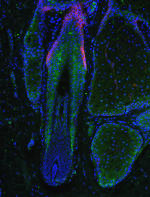Dr. Bernstein answers a frequently asked question about shock fall out after a hair transplant. The answer also touches on the phases of the hair growth cycle.
In this audio clip, Dr. Bernstein answers a frequently asked question. Can tingling on the scalp be an indication of genetic hair loss?
Q: I am 27 years old and I have been on Propecia for 12 months now. Honestly, I have seen no response from it. In my dermatologist’s opinion I am a non-responder. I asked about Avodart and he said, since Propecia didn’t help then Avodart won’t help as well since both are DHT blockers, and if one didn’t work the other won’t either. In your opinion do you think Avodart is better? I have read that it blocks more DHT than Propecia. What is the dosing for Avodart? If someone does not respond to Propecia will they also not respond to Avodart? — A.C., West University Place, Texas
A: Avodart (dutasteride) is more effective than Propecia (finasteride) and some patients will respond to dutasteride who do not respond to finasteride. Dutasteride decreases serum DHT about 90% compared to 70% for finasteride. The usual starting dose of Avodart is 0.5mg a day. That said, it is not FDA approved for use in hair loss and if a person has sexual side effects, the side effects are more likely to be persistent after stopping the medication compared to finasteride.
Q: Can the ARTAS Robot FUE hair transplant be performed on blonds? I heard it only works on dark-haired individuals? — T.W., Jersey City, NJ
A: Correct, robotic FUE doesn’t work well on light-blond or white hair -– but it is easy to dye the hair prior to surgery, and this will solve the problem. We generally advise patients to dye their hair two to three days prior to the procedure so that any residue of the dying still on the scalp can be washed off.
Dr. Bernstein was interviewed by Bloomberg TV’s Matt Miller about robotic hair transplantation and the future of hair transplant surgery in a segment called, “The Bald Economy: Surgical Solutions to Hair Loss.”
 Dr. Bernstein spoke with Bloomberg’s Matt Miller about the future of hair transplantation in a segment called, “The Bald Economy: Surgical Solutions to Hair Loss.” Here is an excerpt from the segment:
Dr. Bernstein spoke with Bloomberg’s Matt Miller about the future of hair transplantation in a segment called, “The Bald Economy: Surgical Solutions to Hair Loss.” Here is an excerpt from the segment:
Bloomberg’s Matt Miller: Riding the wave into the future happens to be one of the pioneers of FUE, Dr. Robert Bernstein.
Dr. Bernstein: “The robot now allows a mechanized system to do [follicular unit extraction] very, very quickly and very consistently, so that the human error in this part of the procedure is now gone.”
 Researchers at the University of Pennsylvania, who were investigating the biological causes of androgenetic alopecia or common genetic hair loss, have discovered that levels of a certain inhibitor protein, called Prostaglandin D2 (PD2), are elevated in bald areas on the scalp. This discovery could be an important breakthrough in developing a medical hair loss treatment that regulates the production of the protein, or one that blocks it from attaching to its receptor protein.
Researchers at the University of Pennsylvania, who were investigating the biological causes of androgenetic alopecia or common genetic hair loss, have discovered that levels of a certain inhibitor protein, called Prostaglandin D2 (PD2), are elevated in bald areas on the scalp. This discovery could be an important breakthrough in developing a medical hair loss treatment that regulates the production of the protein, or one that blocks it from attaching to its receptor protein.
Q: Is taking Propecia absolutely essential to retain the transplanted hair after a hair transplant? — D.W., Toronto, Canada
A: Propecia (Finasteride 1mg) does not affect transplanted hair. The purpose of taking finasteride is to prevent further loss of the non-transplanted hair after the hair restoration procedure.
Synopsis: In addition to acquiring a robotic device, performing FUE hair transplant procedures using a robotic image-guided system requires special surgical facilities, staff training, and modification of the FUE procedure itself. This paper reviews some of the key elements that go into successful implementation of R-FUE into a physician’s practice.
Synopsis: In FUT procedures, once the donor strip is removed, follicular unit dissection and graft insertion can be performed simultaneously. In FUE procedures, graft extraction must be completed before placement can begin, increasing the time grafts are out of the body and subjecting them to hypoxic injury. Waiting for recipient sites to be made adds to this time. These authors suggest creating recipient sites prior to extraction to decrease the time the grafts are outside the body. Other potential advantages of pre-making recipient sites are discussed.





